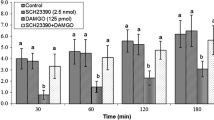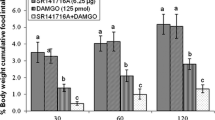Abstract
The aim of the current study was to determine possible interaction of central Opioidergic and Adrenergic systems on food intake regulation in neonatal layer-type chicken. In experiment 1, chicken ICV injected with control solution, DAMGO (µopioid receptors agonist, 125 pmol), parazosin (α1 receptor antagonist, 10 nmol) and DAMGO + parazosin. In experiment 2, control solution, DAMGO (125 pmol), yohimbine (α2 receptor antagonist, 13 nmol) and DAMGO + yohimbine were ICV injected. In experiment 3, FD3 birds ICV injected with control solution, DAMGO (125 pmol), metoprolol (β1 receptor antagonist, 24 nmol) and DAMGO + metoprolol. In experiment 4, FD3 chicks received ICV injection of control solution, DAMGO (125 pmol), ICI 118,551 (β2 receptor antagonist, 5 nmol) and DAMGO + ICI 118,551. Experiments 5–8 were similar to experiments 1–4, except chicken injected with DPDPE (δ opioid receptors agonist, 40 nmol) instead of DAMGO. Experiments 9–12 were similar to experiments 1–4, except chicken injected with U-50488H (κ opioid receptors agonist, 30 nmol) instead of DAMGO. Then, cumulative food intake was recorded at 30, 60 and 120 min after injection. According to the results, ICV injection of the DAMGO significantly decreased food intake while DPDPE and U-50488H significantly increased food intake in neonatal layer type chicken (P < 0.05). Co-injection of the DAMGO + ICI 118,551 decreased DAMGO-induced hypophagia (P < 0.05). Also, co-injection of the DPDPE + parazosin diminished hyperphagic effect of the DPDPE (P < 0.05). In addition, co-injection of the U-50488H + yohimbine diminished U-50488H-induced hyperphagia (P < 0.05). These results suggested there are interconnection between adrenergic and opioidergic systems on central food intake regulation which mediates via α1, α2 and β2 receptors in neonatal layer-type chicken.












Similar content being viewed by others
References
Allgaier C, Daschmann B, Sieverling J, Hertting G (1989) Presynaptic κ-opioid receptors on noradrenergic nerve terminals couple to G proteins and interact with the α2-adrenoceptors. J Neurochem 53:1629–1635
Andrade CAF, Andrade GMF, De Luca Jr LA, Colombari DSA, Menani JV (2007) Interactions between serotoninergic, α2-adrenergic, gabaergic and opioidergic mechanisms of the lateral parabrachial nucleus in the control of NaCl intake. Appetite 49:272–341
Baghbanzadeh A, Hajinezhad MR, Shohreh B, Maleklou R (2010) Intralateral hypothalamic area injection of isoproterenol and propranolol affects food and water intake in broilers. J Comp Physiol A 196:221–226
Benyhe S, Zádor F, Ötvös F (2015) Biochemistry of opioid (morphine) receptors: binding, structure and molecular modeling. Acta Biol Szeged 59(Suppl.1):17–37
Blevins JE, Stanley BG, Reidelberger RD (2002) DMSO as a vehicle for central injections: tests with feeding elicited by norepinephrine injected into the paraventricular nucleus. Pharmacol Biochem Behav 71:277–282
Bungo T, Shimojo M, Masuda Y, Choi YH, Denbow DM, Furuse M (1999) Induction of food intake by a noradrenergic system using clonidine and fusaric acid in the neonatal chick. Brain Res 826:313–316
Bungo T, Kawamura K, Izumi T, Dodo K, Ueda H (2005) Effects of various µ-, δ- and κ-opioid ligands on food intake in the meat-type chick. Physiol Behav 85:519–523
Bungo T, Dodo KI, Izumi T (2007) Central injection of endomorphin-2, but not endomorphin-1, increases food intake in chicks via µ1-opioid receptors. J Poult Sci 44:205–208
Chabot-Doré AJ, Schuster DJ, Stone LS, Wilcox GL (2015) Analgesic synergy between opioid and α2-adrenoceptors. Br J Pharmacol 172:388–402
Crowley NA, Kash TL (2015) Kappa opioid receptor signaling in the brain: Circuitry and implications for treatment. Prog Neuro-Psychopharmacol Biol Psychiatry 62:51–60
da Silva ES, Flores RA, Ribas AS, Taschetto AP, Faria MS, Lima LB, Metzger M, Donato J Jr, Paschoalini MA (2017) Injections of the of the α1-adrenoceptor antagonist prazosin into the median raphe nucleus increase food intake and Fos expression in orexin neurons of free-feeding rats. Behav Brain Res 324:87–95
Davis JL, Masuoka DT, Gerbrandt LK, Cherkin A (1979) Autoradiographic distribution of L-proline in chicks after intracerebral injection. Physiol Behav 22:693–695
Denbow DM (1994) Peripheral regulation of food intake in poultry. J Nutr 124:1349S–1354S
Denbow DM (1999) Food intake regulation in birds. J Exp Zool 283:333–338
Denbow DM, Sheppard BJ (1993) Food and water intake responses of the domestic fowl to norepinephrine infusion at circumscribed neural sites. Brain Res Bull 31:121–128
Denbow DM, Cherry JA, Siegel PB, Van Kery HP (1981) Eating, drinking and temperature response of chicks to brain catecholamine injections. Physiol Behav 27:265–269
Dodo K, Izumi T, Bungo H T (2005) Response of neuropeptide Y-induced feeding to µ-, δ-Ueda and κ-opioid receptor antagonists in the neonatal chick. Neurosci Lett 373:85–88
Feng Y, He X, Yang Y, Chao D, Lazarus LH, Xia Y (2012) Current research on opioid receptor function. Curr Drug Targets 13(2):230–246
Filizola M, Devi LA (2013) Grand opening of structure-guided design for novel opioids. Trends Pharmacol Sci 34(1):6–12
Fukui M, Nakagawa T, Minami M, Satoh M (2001) Involvement of β2-adrenergic and µ-opioid receptors in antinociception produced by intracerebroventricular administration of α,β-methylene-ATP. Jpn J Pharmacol 86:423–428
Furuse M, Matsumoto M, Saito N, Sugahara K, Hasegava S (1997) The central corticotropin-releasing factor and glucagon-like peptide-1 in food intake of the neonatal chick. EurJ Pharmacol 339:211–214
Furuse M, Ando R, Bungo T, Ao R, ShimoJO M, Masuda Y (1999) Intracerebroventricular injection of orexins does not stimulate food intake in neonatal chicks. Br Poult Sci 40:698–700
Hassanpour S, Zendehdel M, Babapour V, Charkhkar S (2015) Endocannabinoid and nitric oxide interaction mediates food intake in neonatal chicken. Br Poult Sci 56(4):443–451
Jonaidi H, Noori Z (2012) Neuropeptide Y-induced feeding is dependent on GABAA receptors in neonatal chicks. J Comp Physiol A 198:827–832
Kaneko K, Yoshikawa M, Ohinata K (2012) Novel orexigenic pathway prostaglandin D2-NPY system-Involvement in orally active orexigenic δ opioid peptide. Neuropeptides 46:353–357
Kanzler SA, Januario AC, Paschoalini MA (2011) Involvement of β3 -adrenergic receptors in the control of food intake in rats. Braz J Med Biol Res 44(11):1141–1147
Lei S (2014) Cross interaction of dopaminergic and adrenergicsystems in neural modulation. Int J Physiol Pathophysiol Pharmacol 6(3):137–142
Manglik A, Kruse AC, Kobilka TS, Thian FS, Mathiesen JM, Sunahara RK, Pardo L, Weis WI, Kobilka BK, Granier S (2012) Crystal structure of the µ-opioid receptor bound to a morphinan antagonist. Nature 485:321–326
Olanrewaju HA, Purswell J, Collier SD, Branton SL (2017) Effects of light ingress through ventilation fan apertures on selected blood variables of male broilers. Int J Poult Sci 16:288–295
Parker KE, Johns HW, Floros TG, Will MJ (2014) Central amygdala opioid transmission is necessary for increased high-fat intake following 24-h food deprivation, but not following intra-accumbens opioid administration. Behav Brain Res 260:131–138
Qi W, Ding D, Salvi RJ (2008) Cytotoxic effects of dimethyl sulphoxide (DMSO) on cochlear organotypic cultures. Hear Res 236:52–60
Ramanathan R, Cryer PE (2011) Adrenergic mediation of hypoglycemia-associated autonomic failure. Diabetes 60(2):602–606
Richards MP (2003) Genetic regulation of feed intake and energy balance in poultry. Poult Sci 82:907–916
Root-Bernstein R, Turke M, Subhramanyam UKT, Churchill B, Labahn J (2018) Adrenergic agonists bind to adrenergic-receptor- like regions of the mu opioid receptor, enhancing morphine and methionine-enkephalin binding: a new approach to “Biased Opioids”? Int J Mol Sci 19:272. https://doi.org/10.3390/ijms19010272
Rozenfeld R, Devi LA (2011) Exploring a role for heteromerization in GPCR signaling specificity. Biochem J 433:11–18
Saito ES, Kaiya H, Tachibana T, Denbow DM, Kangawa K, Furuse M (2005) Inhibitory effect of ghrelin on food intake is mediated by the corticotropin-releasing factor system in neonatal chicks. Regul Pept 125:201–208
Sharkey KA, Darmani NA, Parker LA (2014) Regulation of nausea and vomiting by cannabinoids and the endocannabinoid system. Eur J Pharmacol 722:134–146
Shojaei M, Zendehdel M, Babapour V, Charkhkar S, Hassanpour S (2015) Opioid-induced hypophagia is mediated by 5-HT2c receptors in neonatal layer-type chicken. Czech J Anim Sci 60(9):400–410
Tachibana T, Sugahara K, Ueda H, Cline MA (2009) Role of adrenergic alpha-2-receptors on feeding behavior in layer-type chicks. Gen Comp Endocrinol 161:407–411
Tan M, Walwyn WM, Evans CJ, Xie CW (2009) -Arrestin 2 mediate functional interactions between endogenous bp38 map kinase and 2A-adrenergic receptors in neurons. J Biol Chem 284(10):6270–6281
Trujillo KA, Smith ML, Guaderrama MM (2011) Powerful behavioral interactions between methamphetamine and morphine. Pharmacol Biochem Behav 99:451–458
Tsujii S, Bray GA (1998) A beta-3 adrenergic agonist (BRL-37,344) decreases food intake. Physiol Behav 63:723–728
Van Tienhoven A, Juhasz LP (1962) The chicken telencephalon, diencephalon and mesencephalon in sterotaxic coordinates. J Comp Neurol 118:185–197
Wellman PJ (1992) Overview of adrenergic anorectic agents. Am J Clin Nutr 55(1):193S–198S
Yanagita K, Shiraishi J, Fujita M, Bungo T (2008) Effects of N-terminal fragments of β-endorphin on feeding in chicks. Neurosci Lett 442:140–142
Zendehdel M, Hassanpour S (2014) Ghrelin-induced hypophagia is mediated by the β2 adrenergic receptor in chicken. J Physiol Sci 64:383–391
Zendehdel M, Ghashghayi E, Hassanpour S, Baghbanzadeh A, Jonaidi H (2016) Interaction between opioidergic and dopaminergic systems on food intake in neonatal layer type chicken. Int J Pept Res Ther 22:83–92
Zendehdel M, Parvizi Z, Hassanpour S, Baghbanzadeh A, Hamidi F (2017) Interaction between nociceptin/orphanin FQ and adrenergic system on food intake in neonatal chicken. Int J Pept Res Ther 23:155–161
Zheng H, Patterson LM, Berthoud HR (2007) Orexin signaling in the ventral tegmental area is required for high-fat appetite induced by opioid stimulation of the nucleus accumbens. J Neurosci 27:11075–11082
Acknowledgements
The authors thank the central laboratory (Dr. Rastegar Lab.) of the Faculty of Veterinary Medicine, University of Tehran for cooperation. This research is conducted as a part of the PhD thesis of the first author.
Author information
Authors and Affiliations
Corresponding author
Ethics declarations
Conflict of interest
The authors declare that they have no conflict of interest.
Informed Consent
This manuscript does not contain any studies with human subjects performed by any of the authors.
Research Involving Human and Animal Rights
All experiments were executed according to the Guide for the Care and Use of Laboratory Animals and were approved by the institutional animal ethics committee.
Additional information
Publisher’s Note
Springer Nature remains neutral with regard to jurisdictional claims in published maps and institutional affiliations.
Rights and permissions
About this article
Cite this article
Nayebzadeh, N., Vazir, B., Zendehdel, M. et al. Central Opioidergic and Adrenergic systems Mediates Food Intake via α1, α2 and β2 Receptors in Neonatal Layer-Type Chicken. Int J Pept Res Ther 26, 1–10 (2020). https://doi.org/10.1007/s10989-019-09810-w
Accepted:
Published:
Issue Date:
DOI: https://doi.org/10.1007/s10989-019-09810-w




